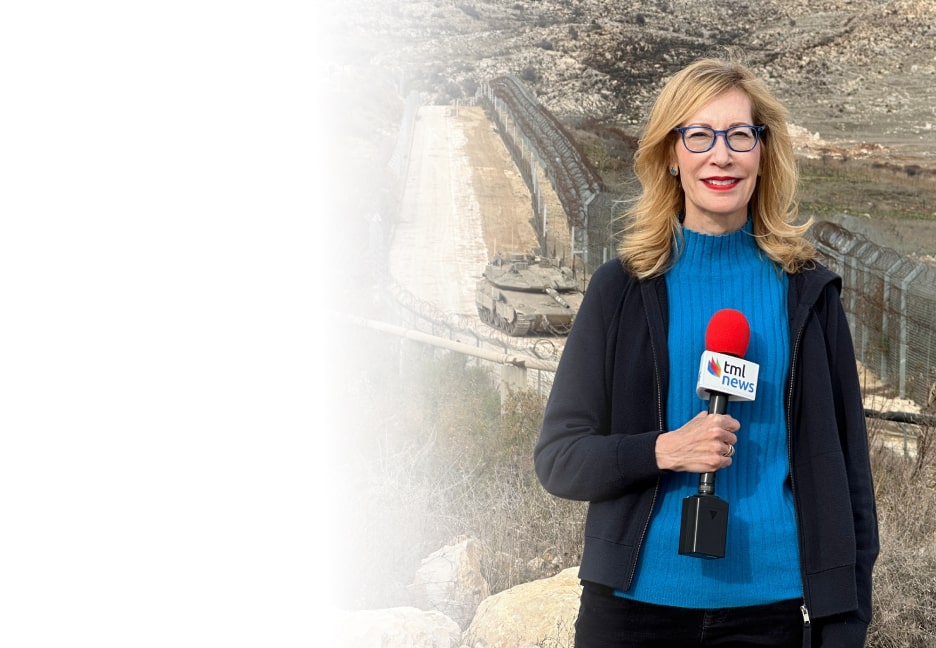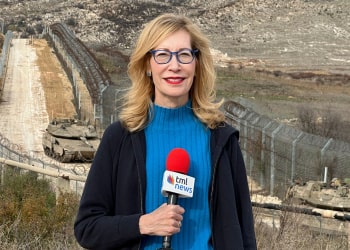[Quneitra, Syria] “I had 60 head of cattle—only 30 are left,” said Muammar Khairallah, an olive farmer and herder near Tel al-Ahmar al-Gharbi, about 37 miles southwest of Damascus. “Now the rains are gone, the roads are blocked, and my cows are dying.”
We used to make $20,000 a season in net profit. Now the profit is zero.
Khairallah told The Media Line that his 20-acre farm includes about 1,500 olive trees and, until recently, produced up to 40,000 pounds of olives per year—about 150 tins of olive oil. “We used to make $20,000 a season in net profit,” he said. “Now the profit is zero.”
Falling rainfall and rising costs for fertilizer, feed, and fuel have devastated both livestock and crops. Khairallah said his farm now has only half the cattle it once did, and his remaining well is inadequate for irrigation due to limited electricity and expensive water deliveries. “A 1,050-gallon water truck costs 150,000 Syrian pounds [about $15],” he said. “And it’s often not clean.”
This means up to 12% of Khairallah’s former seasonal income would now go toward water delivery—water he says is “often not clean.” In contrast, typical irrigation costs for farmers in Israel, Jordan, or the US account for just 1% to 3% of operational income, according to regional agricultural data and World Bank figures.
His farm once supported 15 families—around 75 people—and provided seasonal jobs. No government or aid agency assistance has reached them, he said. “There’s a well, but it’s only for household use because of poor rainfall and electricity,” he added. “We were offered help by the Israeli army, but we refused.”
The land Khairallah works lies just yards from Israeli-controlled territory. What used to be a quiet buffer zone is now increasingly militarized. Israeli incursions across the Golan frontier are taking place during one of the worst drought years in recent memory, and locals say the twin burdens of climate stress and conflict are pushing their villages to the edge.
Residents and local officials say military activity, infrastructure damage, and government neglect have together pushed southwest Syria’s agricultural life toward collapse. The combined effects of conflict and climate change have left entire communities scrambling for access to water.
Between May 14 and 21, the Syrian Observatory for Human Rights reported Israeli military activity near Jaba, Jabata al-Hashab, Rasem al-Halabi, and Quneitra city, about 3 miles from the Israeli border.
Footage published by the Horan Free Union and Quneitra al-Youm shows shattered water pipes and solar panels in Tel al-Ahmar, a town once known for its orchards.
Mohammed Fawaz Al-Abdullah, an employee at the Al-Asbah water station under the Quneitra Directorate of Drinking Water, told The Media Line that Israeli military actions had directly affected the water system serving nine villages: Kodna, Al-Ajraf, Al-Hayadera, Rasm Sanad, Abu Qubais, Al-Fityan, Al-Maqta’a, Al-Asbah, and Al-Asha.
“On December 12, 2024, the Israeli army entered Tel al-Ahmar immediately after the regime collapsed,” he said. “Since then, we’ve been unable to access the wells or the station, which caused a water shortage across all the villages the station serves.”
This holiday season, give to:
Truth and understanding
The Media Line's intrepid correspondents are in Israel, Gaza, Lebanon, Syria and Pakistan providing first-person reporting.
They all said they cover it.
We see it.
We report with just one agenda: the truth.



Drought and road closures have devastated the Khairallah family farm near Tel al-Ahmar al-Gharbi, Syria, wiping out half the cattle herd and destroying the olive harvest, once a key source of income. May 29, 2025. (Ahmed Qwaidar/The Media Line)
He described in detail the destruction of the northern well in Kodna on December 18, 2024. “The well had a full perimeter wall with a gate and three rooms: one for the generator, one for the electrical panels, and a guard room with a bathroom and sink,” Al-Abdullah said. “The entire well was destroyed and put out of service. The generator was also disabled completely.”
We weren’t allowed to bring in heavy machinery to clear the rubble for three months
While the team was eventually able to restart the well with minimal equipment, restoring full service proved impossible due to Israeli restrictions. “We weren’t allowed to bring in heavy machinery to clear the rubble for three months,” he said. “The Israeli army did not permit us to bring in any heavy equipment.”
Then, on May 29, 2025, Al-Abdullah said he was doing repair work at the Ain Ziwan well when Israeli soldiers unexpectedly arrived. “They started asking about the Ain Ziwan well, the destroyed northern Kodna well, and the solar-powered well where six solar panels had been damaged by gunfire from the Israeli army,” he said. “They told us, ‘We want to fully rebuild it and replace the solar panels.’”
Al-Abdullah replied that any restoration would need to go through official channels. “I told them: ‘The United Nations is involved. I’m just an employee at the station. Any coordination must go through the United Nations, then to the governor and the water director.’”
According to him, the Israeli officer said the Israel Defense Forces (IDF) would coordinate with the UN and send a formal letter to the local governor requesting permission to rebuild.
Footage circulating on Syrian social media, reviewed by The Media Line, shows an Israeli patrol being confronted by civilians near the Rwihinah Dam, less than 2 miles from the Israeli border. The video, shared by Syria TV, shows residents objecting to the IDF’s presence and calling for their withdrawal. While the soldiers are not seen using force, the exchange reflects rising civilian resistance to Israel’s growing military footprint in southern Syria.
The TML-verified video shows civilians confronting an Israeli patrol on May 30 near Rwihinah Dam in the Quneitra countryside after soldiers attempted to prevent residents from entering an area they often visit for family gatherings.
Although the IDF has not released recent statements specifically addressing Quneitra, Israeli officials have cited concerns about preventing armed groups from establishing positions near the border. Israeli media reports say IDF troops briefly entered the village of Ma’ariya in the Yarmouk Basin of western Daraa on May 20, 2025.
Some analysts say IDF units are now staying in buffer zones after operations, rather than retreating as they did in the past. Former Israeli National Security Council head Maj. Gen. (ret.) Giora Eiland told Kan News in May that “as long as Iranian proxies threaten our northern front, there’s logic in maintaining a forward presence.”
Engineer Bassam Al-Shamali, director of Quneitra’s water department, told The Media Line that rainfall this season has totaled just 7.8 inches—far below the governorate’s 29.5-inch average. “Most dams and springs have dried up, and many wells are out of service,” he said. “The drought is unprecedented.”
He added that Quneitra’s six dams are now holding less than 15% of last year’s water, with only 4.8 billion gallons of carryover water shared between Quneitra and Daraa for winter crops. “Surface wells are already going dry, especially those under 164 feet deep,” he said. “We fear many of them will completely fail during the hot summer months.”
To manage the shortfall, Al-Shamali’s team is releasing water in small, spaced-out quantities. “We’re sending out small quantities with long gaps in between—just enough to keep the farmers from giving up,” he said.
Some infrastructure experts say there may be a path forward. “These aren’t massive urban systems,” Dr. Clive Lipchin, director of the Center for Transboundary Water Management at Israel’s Arava Institute, told The Media Line. “We’re talking about rural, relatively small networks—that makes repairs more feasible.”
“A functioning rural well system for nine villages—depending on depth, energy supply, and distribution—could be rebuilt for around $200,000 if you’re using regional contractors and solar power,” he said.
Still, security concerns complicate matters. “If the well is going to be near contested zones or military patrol areas, you’ll need guarantees that civilian workers can go in and out safely,” Lipchin added. “Without that, even the best technology won’t help. That’s where diplomacy meets infrastructure.”
Recent reports from the United Nations reflect how severe Syria’s water crisis has become. The 2024 UN Country Results Report states that more than 4 million people required assistance to access clean water and sanitation. According to OCHA, 16.7 million Syrians needed aid this year, with water shortages listed among the most urgent challenges.
As the dry season tightens and military patrols increase, residents of Quneitra brace for further losses. “We’re not asking for favors,” said Khairallah. “Just let us farm. Let us water our trees. Let us live.”
Just let us farm. Let us water our trees. Let us live.
Even with the uncertainty, some experts believe limited cooperation may still be possible. “You don’t need a treaty to repair a well,” Lipchin said. “But you do need someone both sides can trust.”